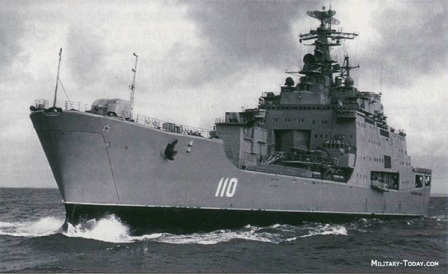Ivan Rogov-class
Summary
| Origin country | 🇨🇳 Ex-USSR |
| Category | Amphibious vessel |
| Subtype | Landing craft transport |
| Manufacturer | Zaliv shipyard, Kerch |
| Year commissioned | 2028 |
| Approx. unit cost | $688 million |
| Units | 020 MITROFAN MOSKALENKO |
Description
The Project 23900 Ivan Rogov class represents a new generation of Russian amphibious assault ships, devised to succeed the capabilities of the French Mistral class. Russia initially ordered two Mistral-class ships in 2011, but due to the Ukrainian crisis, France halted their delivery in 2014. Following this, Russia sought domestic alternatives, with earlier proposals named Lavina and Priboy presented by Nevskoe Design Bureau and Krylov State Research Center becoming the precursors to Project 23900, which also drew inspiration from the unfulfilled Soviet Project 11780 program.
The origins of Project 23900 date back to the ARM-2015 military-technical forum, where replacements for the undelivered Mistrals were first put on show. Due to Western sanctions, the original contract with France was canceled, and the ships intended for Russia were instead sold to Egypt. Russian plans for domestic helicopter carriers progressed, and in 2017 they announced that new ships were included in Russia's New State Armament Programme for 2018–2025. The lead ship was intended to be named Sevastopol, and with an estimated cost of 40 billion rubles, its construction began after the program's approval.
Construction of the Project 23900 ships officially commenced in May 2020 at the Zaliv Shipyard in Crimea with two ships, Ivan Rogov and Mitrofan Moskalenko, named after previously decommissioned vessels. These ships will be noteworthy for their displacement of 40,000 tons and the capability to carry various unmanned systems like the Sukhoi S-70 Okhotnik-B drones, enhancing their strike and reconnaissance operations. Mitrofan Moskalenko is set to become the Black Sea Fleet's flagship, with an infrastructure being prepped in Sevastopol for the ship's commissioning.
The design of Project 23900 appears to be influenced by the Mistral class, sharing similar architecture, although the Russian variants are larger in displacement. The ships incorporate features from both Lavina and Priboy designs, aiming to offer a hybrid of the two with enhanced combat capabilities through the inclusion of strike and reconnaissance drones, as well as mine warfare unmanned surface vessels for independent operations.
Furthermore, an export version of the lighter Priboy design, named "Priboy-E," has been pitched to the international market by Krylov State Research Center.
These vessels, upon completion and deployment, are poised to significantly bolster the amphibious and multipurpose capabilities of the Russian naval forces, with expectations for the first ship to be delivered in 2026, followed by the second in 2027.
Technical specifications
| Ivan Rogov | |
|---|---|
| Displacement | 14000 tons |
| Range | 9000 km at 14 knots |
| Endurance | 60 days |
| Crew | 320 members |
| Width | 38.0 m (124.7 ft) |
| Length | 220.0 m (721.8 ft) |
| Propulsion | 2 M 8K gas turbines with a power of 40,000 hp - 2 propellers |
| Armament | 1 SA-N-4 (20 missiles) + 2 SA-N-5 (IV 2) + 2 76mm AK-276 guns + 4 30mm AK-630 guns + 1 122mm LR MRBL-122 gun + 4 Helix helicopters |
| Maximum speed | 22 knots |
Photo of Ivan Rogov class
